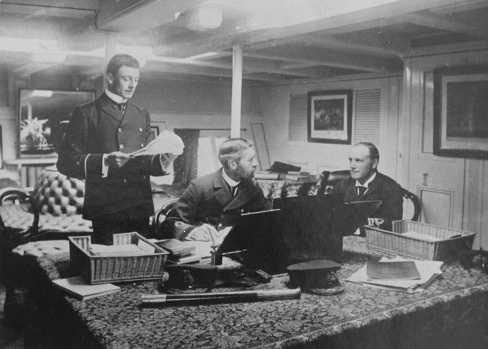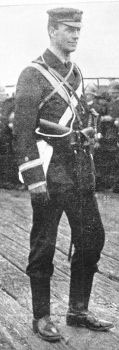In Part I of the Alfred Treacy story, the author traces Treacy’s career in the Victorian Navy between 1894 to 1901, the Commonwealth Naval Forces between 1901 and 1911 and his years in the RAN until 1914. Part II will continue with Treacy’s career through to retirement in 1922, and beyond…
…Some RAN Supply Branch personnel may recall from their time at HMAS Cerberus that the building that houses the Supply and Health Faculty is called the Treacy Building. Some may even have read the small bronze plaque that was placed on the lower floor of the building, in 1979, and which briefly describes the man after whom the building is named: but who was Treacy and why is he the father of the RAN Supply Branch?
Alfred Martin Treacy was born in the central Victorian town of Newstead on 28 April 1869, the son of Irish parents John Treacy, publican of a local hotel, and Mary Margaret Treacy (nee Hogan). He had a strict Roman Catholic upbringing and after his schooling joined the Victorian Public Service as an accountant. In early 1894 he applied to join the Victorian Navy as a Paymaster officer and commenced service in the permanent forces on 21 May 1894. In 1894 the Victorian Navy was the largest of the state navies with some 240 permanent personnel and 350 reservists (the Victorian Naval Brigade) and the fleet consisted of the flagship HMVS Nelson, monitor HMVS Cerberus, two gunboats and five torpedo boats. Financially the maintenance of such a large fleet was a drain on the Victorian economy and several of the ships were often held in reserve with only skeleton crews.

Treacy entered the service as a Paymaster’s Clerk (equivalent to a Midshipman) in what was then known as the Accountant Branch. On entry he was described as 6 feet 1 inch tall with brown hair and blue eyes. On 1 July 1895 he was promoted to Assistant Paymaster (equivalent to a Sub-Lieutenant) and five years later, on 21 July 1900, he was promoted to Paymaster (equivalent to a Lieutenant). He spent most of his time either working onboard the flagship Nelson, the monitor Cerberus or at the Williamstown Naval Depot.
In March 1900 the Boxer Rebellion broke out in China and Britain found itself short of troops to deal with the uprising. Britain was as that time fighting a significant war in South Africa against the Boer Republics. Victoria, New South Wales (NSW), Queensland and South Australia all offered naval forces to support the British cause and Victoria provided a 200 man naval brigade. Treacy became the units’ Paymaster responsible for not only pay but all provisions, stores, equipment and administration. The Victorian contingent embarked in the troopship Salamis in early August, along with 260 men from the NSW Naval Brigade and sailed for China on 8 August 1900. South Australia provided the cruiser Protector which was attached to the Royal Navy Squadron operating in the Gulf of Chihli (Bo Hai). The Queensland Government offered a gunboat but it was rejected as too old and slow.
The Victorian Contingent arrived in China on 9 September, but by then much of the heavy fighting against the Boxers was over and they operated mainly as a police force maintaining the peace and re-asserting the rule of the foreign Governments in China. Treacy was described as a capable officer who was able to maintain the logistics support needed by contingent, but claims, at the time, that he was involved in close fighting with the Boxers can not be substantiated. In March 1901 the Victorian and NSW Naval Contingents embarked in the troopship Chingtu and returned to Australia.
They steamed in Sydney Harbour on 25 April 1901 to find that Australia was now a Federation and the old state navies were now to be subsumed into what would become the Commonwealth Naval Forces (CNF). In the mean time, however, the Victorians were held onboard the Chingtu, due to an outbreak of Smallpox, until 3 May when the boarded a train for return to Melbourne the following day. For his service in China, Treacy was awarded the China War Medal 1900 and most likely he also purchased a private award – The Military Order of the Dragon which was available for all commissioned officers for the then princely sum of 10 US Dollars.

As a permanent member of the Victorian Navy, Treacy was automatically transferred to the CNF but it was not until 1904 that naval administration was centralised and for some time the state navies continued to operate very much on a state basis. He served almost continuously as the Paymaster in HMCS Cerberus from 1901 until 1911. Although Cerberus had now been afloat for over 30 years she was still a sea-going vessel and regularly carried out naval exercises in Port Phillip Bay before becoming the static depot ship, at Williamstown, in May 1914.
On 8 September 1906 Treacy was promoted to the rank of Staff Paymaster (equivalent to a Lieutenant Commander). In August/September 1908 the United States Navy ‘Great White Fleet’ visited Melbourne and men and ships of the CNF were fully employed in supporting this visit. On 1 March 1911 Treacy married Alice Maud Keilora Robertson, with Presbyterian rites, at a private residence, Wiljah, in South Yarra, Melbourne. They then lived at Jandra, 70 Clendon Road, in Toorak. At the time of their marriage Alfred was 41 and Alice was 39. They were to be married for 27 years but had no children.
Shortly after being married Treacy was sent to England for a period of training and was attached to the staff at the Admiralty. During this time he was part of the 37-man Australian Naval Contingent which attended the Coronation celebrations for King George V, who was crowned at Westminster Abbey on 22 June 1911. Treacy was subsequently awarded the 1911 Coronation Medal. When he returned to Australia in 1912 it was as an officer in the Royal Australian Navy which the CNF had become on 10 July 1911.
After his return to Australia Treacy became the Director of Naval Stores, Victualling and Contracts at Navy Office; then located in Melbourne. He was promoted to the rank of Fleet Paymaster (equivalent to a Commander) on 1 July 1912. In October 1913 he applied to the Minister for Defence to be considered for the position of Finance and Civil Member (Fourth Naval Member) and Secretary to the Naval Board. This position was then held by Paymaster in Chief (equivalent of a Captain) Henry Manisty, RN who was due to retire in mid 1914. The Minister For Defence, Senator Edward Millen, stated in late December 1913 that ‘As no vacancy exists the submission of such an application is both surprising and reprehensible’. Treacy took offence to these comments and further explained himself to the Minister and the word reprehensible was later withdrawn by the Minister….To be continued.
Contact Greg Swinden about this article.






